Types of Windows - Beyond the Glass

The market offers a wide range of options in order to choose the most suitable types of windows for your home, both from a technical – insulation, ventilation, lighting – and aesthetic perspective.
The basic principles of any window, regardless of its size and shape, are always the same: they must allow the natural light through and provide proper ventilation around the house.
Optimal use will depend, mainly, on the correct choice of the material used to make it and its opening system, without overlooking safety.
Another of its fundamental purposes is to provide thermal and acoustic insulation and to stop water, air, and dust from coming into the house. Easily closing and opening the window is also a must.
An important thing is windows must be easy to clean from the outside and inside, and be manageable, especially when it comes to replacing the glass.
The importance of the various types of windows
We’re going to name the main types of windows so you have several options to choose from. Think about which would be better in your home.
Fixed windows
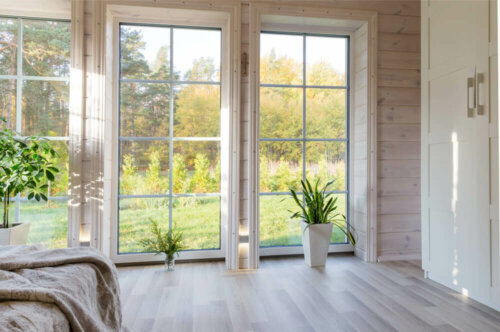
These have a simple frame with glass and are mainly for allowing light through. They don’t open for ventilation though. You can usually find them combined with other types of windows. Also, note that you should only install them if you can easily clean them from the outside.
Casement windows
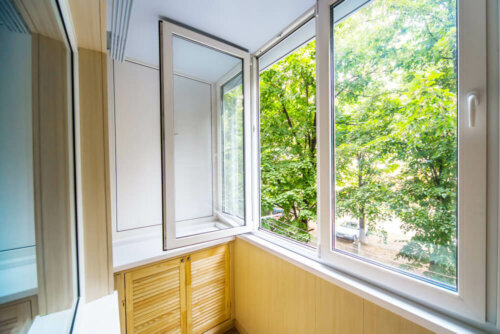
These are the most widely used type of window. You can open them inwards or outwards, and they’re airtight when you close them. They fit perfectly when they have a frame. In addition, they’re the most practical for natural ventilation in a house.
Casement windows are easy to clean, although one of their drawbacks is they need more interior space to open, which makes it hard to place furniture or lamps on the side they open.
Another problem is it’s difficult to control exactly how much they open and strong air currents could break them. So, you must carefully consider where in the house to put them.
Center pivot windows
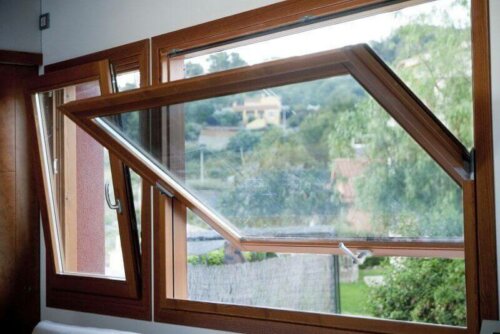
These have windowpanes that rotate on a fixed axis located in the center of the frame and open inwards. Traditionally, they’re installed in lofts, roofs, and large rooms.
They allow proper ventilation while they’re also good for preventing strong drafts. In addition, they’re safe, don’t take up too much extra space, and are easy to clean. Especially if they’re the kind that rotates 180 degrees.
Among their drawbacks, they hinder the interior space, and their manufacturing, installation, and accessories are expensive.
Double or single hung sash windows
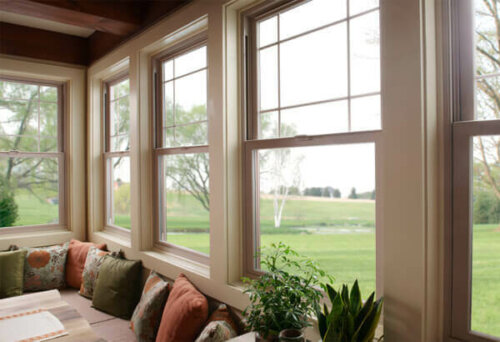
These are made up of two panes, one which you can move up and down, and are ideal for bathrooms or small rooms. They need care and maintenance but are worth installing because they save space and allow natural light in.
A drawback is they reduce the air intake since you can only open half of the window, leading to poorer ventilation.
Sliding windows
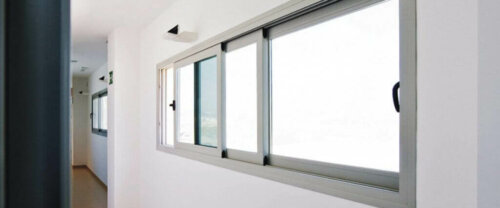
These can take advantage of space but reduce ventilation by half since the panes slide laterally on top of each other.
They’re usually installed in small rooms, and it’s very difficult to clean them if there’s no access to the outside. However, it’s possible to do so from the inside when the window isn’t too large and you can easily remove it.
Hopper windows
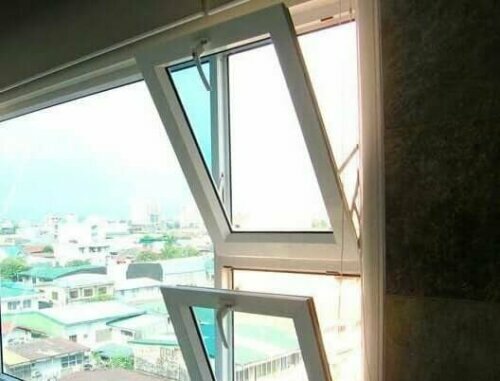
You can open these downward or upward, depending on the placement of their hinges. They’re common as vents and for where you want to put furniture underneath them.
They’re very practical in houses with children, since they’re safe because they don’t allow the full opening of the pane. One of their drawbacks is they’re difficult to clean.
Tilt and turn

You can find these in modern homes and they consist of a mechanism that allows you to fully open the window; at the same time, they also have a device to partially open the upper part.
They can be expensive, but they help solve space problems.
Porthole windows

Round and inspired by ship skylights, portholes are usually fixed windows consisting only of a frame and glass. They have a decorative function and are very useful in small rooms.
There’s one model with a half mobile circumference, hinged to the fixed half. However, you should only place them where you have access to the outside to ensure cleaning.
Jalousie windows
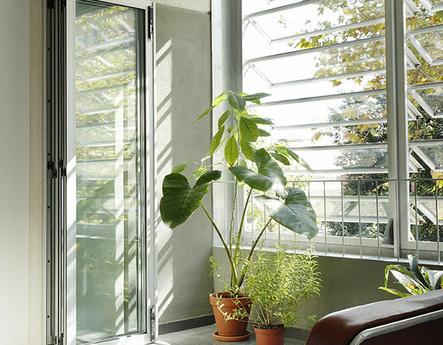
These windows are frequently used in kitchens and bathrooms. This is because they save space and offer a much larger ventilation surface than sliding windows.
In addition, they allow direct control of the airflow that enters the room. Their benefits have improved in recent years since they’re now safer and more airtight.
Also, the new models open completely outwards, without taking up the interior space. This is good because it saves space and makes cleaning easier.
We’re sure this article will help you see the light and hope it’s useful in helping you choose the future windows of your home.
The market offers a wide range of options in order to choose the most suitable types of windows for your home, both from a technical – insulation, ventilation, lighting – and aesthetic perspective.
The basic principles of any window, regardless of its size and shape, are always the same: they must allow the natural light through and provide proper ventilation around the house.
Optimal use will depend, mainly, on the correct choice of the material used to make it and its opening system, without overlooking safety.
Another of its fundamental purposes is to provide thermal and acoustic insulation and to stop water, air, and dust from coming into the house. Easily closing and opening the window is also a must.
An important thing is windows must be easy to clean from the outside and inside, and be manageable, especially when it comes to replacing the glass.
The importance of the various types of windows
We’re going to name the main types of windows so you have several options to choose from. Think about which would be better in your home.
Fixed windows

These have a simple frame with glass and are mainly for allowing light through. They don’t open for ventilation though. You can usually find them combined with other types of windows. Also, note that you should only install them if you can easily clean them from the outside.
Casement windows

These are the most widely used type of window. You can open them inwards or outwards, and they’re airtight when you close them. They fit perfectly when they have a frame. In addition, they’re the most practical for natural ventilation in a house.
Casement windows are easy to clean, although one of their drawbacks is they need more interior space to open, which makes it hard to place furniture or lamps on the side they open.
Another problem is it’s difficult to control exactly how much they open and strong air currents could break them. So, you must carefully consider where in the house to put them.
Center pivot windows

These have windowpanes that rotate on a fixed axis located in the center of the frame and open inwards. Traditionally, they’re installed in lofts, roofs, and large rooms.
They allow proper ventilation while they’re also good for preventing strong drafts. In addition, they’re safe, don’t take up too much extra space, and are easy to clean. Especially if they’re the kind that rotates 180 degrees.
Among their drawbacks, they hinder the interior space, and their manufacturing, installation, and accessories are expensive.
Double or single hung sash windows

These are made up of two panes, one which you can move up and down, and are ideal for bathrooms or small rooms. They need care and maintenance but are worth installing because they save space and allow natural light in.
A drawback is they reduce the air intake since you can only open half of the window, leading to poorer ventilation.
Sliding windows

These can take advantage of space but reduce ventilation by half since the panes slide laterally on top of each other.
They’re usually installed in small rooms, and it’s very difficult to clean them if there’s no access to the outside. However, it’s possible to do so from the inside when the window isn’t too large and you can easily remove it.
Hopper windows

You can open these downward or upward, depending on the placement of their hinges. They’re common as vents and for where you want to put furniture underneath them.
They’re very practical in houses with children, since they’re safe because they don’t allow the full opening of the pane. One of their drawbacks is they’re difficult to clean.
Tilt and turn

You can find these in modern homes and they consist of a mechanism that allows you to fully open the window; at the same time, they also have a device to partially open the upper part.
They can be expensive, but they help solve space problems.
Porthole windows

Round and inspired by ship skylights, portholes are usually fixed windows consisting only of a frame and glass. They have a decorative function and are very useful in small rooms.
There’s one model with a half mobile circumference, hinged to the fixed half. However, you should only place them where you have access to the outside to ensure cleaning.
Jalousie windows

These windows are frequently used in kitchens and bathrooms. This is because they save space and offer a much larger ventilation surface than sliding windows.
In addition, they allow direct control of the airflow that enters the room. Their benefits have improved in recent years since they’re now safer and more airtight.
Also, the new models open completely outwards, without taking up the interior space. This is good because it saves space and makes cleaning easier.
We’re sure this article will help you see the light and hope it’s useful in helping you choose the future windows of your home.







